Co-existing anxiety disorders and depression
- Adam Lukeman, LCSW

- Mar 5, 2016
- 1 min read
Updated: Jun 27, 2020

INTRODUCTION — Anxiety disorders and depressive disorders are highly prevalent conditions that frequently co-occur. Individuals affected by both anxiety and depressive disorders concurrently have generally shown greater levels of functional impairment, reduced quality of life, and poorer treatment outcomes compared with individuals with only one disorder. Studies of the clinical presentation, course, assessment, and diagnosis of these conditions have largely focused on the co-occurrence of depression and generalized anxiety disorder. The diagnosis of these conditions is complicated by the presence of mixed anxiety and mood states as well as substantial overlap in physical and emotional symptoms of the disorders. Anxious distress was included as a subtype of major depression in the Diagnostic and Statistical Manual of Mental Disorders, Fifth Edition (DSM-5) [1]. This topic describes the epidemiology, pathogenesis, clinical manifestations, course, and diagnosis of comorbid anxiety and depression. The treatment of comorbid anxiety and depression is discussed elsewhere. The epidemiology, pathogenesis, clinical manifestations, course, diagnosis, and treatment of individual depressive and anxiety disorders are also described separately. (See "Unipolar depression in adults: Epidemiology, pathogenesis, and neurobiology" and "Unipolar depression in adults: Assessment and diagnosis" and "Unipolar depression in adults: Course of illness" and "Generalized anxiety disorder: Epidemiology, pathogenesis, clinical manifestations, course, assessment, and diagnosis" and "Social anxiety disorder: Epidemiology, clinical manifestations, and diagnosis" and "Obsessive-compulsive disorder in adults: Epidemiology, pathogenesis, clinical manifestations, course, and diagnosis" and "Panic disorder: Epidemiology, pathogenesis, clinical manifestations, course, assessment, and diagnosis" and "Agoraphobia in adults: Epidemiology, pathogenesis, clinical manifestations, course, and diagnosis".) - See more at: http://www.adamlukeman.com/self-help#sthash.iQYgYRsF.dpuf






















































Comments